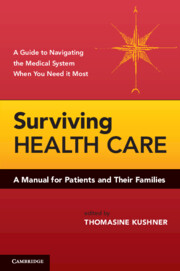Book contents
- Frontmatter
- Contents
- Contributors
- Preface
- 1 Letter to Patients
- 2 Becoming an Active Member of Your Health Care Team
- 3 Information That Will Help You with Advance Planning for Your Health Care
- 4 Responding to Medical Emergencies
- 5 What You Need to Know about Medical Errors
- 6 Being Informed When You Give Consent to Medical Care
- 7 Beware of Scorecards
- 8 Transplantation 101
- 9 When the Illness Is Psychiatric
- 10 On the Horizon
- 11 To Be or Not to Be – A Research Subject
- 12 Information That Will Help You Make Health Care Decisions for Adult Family Members
- 13 Caring for Individuals with Alzheimer's Disease
- 14 When the Patient Is a Child
- 15 Care of Elders
- 16 Being and Thinking
- 17 A Patient's Guide to Pain Management
- 18 The Hardest Decisions
- 19 What You Need to Know about Disasters
- 20 Making the Internet Work for You
- Appendix: Patient Individual Profile
- Index
10 - On the Horizon
Genetic Testing
Published online by Cambridge University Press: 05 June 2012
- Frontmatter
- Contents
- Contributors
- Preface
- 1 Letter to Patients
- 2 Becoming an Active Member of Your Health Care Team
- 3 Information That Will Help You with Advance Planning for Your Health Care
- 4 Responding to Medical Emergencies
- 5 What You Need to Know about Medical Errors
- 6 Being Informed When You Give Consent to Medical Care
- 7 Beware of Scorecards
- 8 Transplantation 101
- 9 When the Illness Is Psychiatric
- 10 On the Horizon
- 11 To Be or Not to Be – A Research Subject
- 12 Information That Will Help You Make Health Care Decisions for Adult Family Members
- 13 Caring for Individuals with Alzheimer's Disease
- 14 When the Patient Is a Child
- 15 Care of Elders
- 16 Being and Thinking
- 17 A Patient's Guide to Pain Management
- 18 The Hardest Decisions
- 19 What You Need to Know about Disasters
- 20 Making the Internet Work for You
- Appendix: Patient Individual Profile
- Index
Summary
Scientific developments in the field of genetics are being referred to as a “revolution.” One demonstration of that revolution is the recent dramatic growth in the number and availability of genetic tests. Today, more than 1,500 clinically applicable genetic tests are available. Many experts tout our developing genetic testing capability as the dawning of a new age in medicine's ability to diagnose, treat, and prevent illness, whereas others fear its abuse. This chapter discusses basic concepts in genetics, addresses more focused questions relating to genetic testing, and makes recommendations about whether genetic testing is right for you and, if so, how to proceed.
The Basics
Genetic testing has both benefits and limitations, and the decision whether to be tested is personal and complex. It is important to start with an understanding of the basics.
Cells are basic building blocks of all living things. The human body is composed of trillions of cells, which provide structure for the body, take in nutrients and convert these to energy, carry out specialized functions, and contain the body's hereditary materials.
DNA (deoxyribonucleic acid) residing within the nucleus of each cell constructs the blueprint for making proteins that build cells, tissues, and enzymes that trigger biochemical reactions in cells. The structure of DNA is a two-stranded, spiraled double-helix. Every cell in your body (except for mature red blood cells, which have no nucleus) contains the same DNA.
RNA, or ribonucleic acid, receives instructions from DNA and carries them to the ribosome, the site of protein synthesis in the cell.
[…]
Keywords
- Type
- Chapter
- Information
- Surviving Health CareA Manual for Patients and Their Families, pp. 136 - 145Publisher: Cambridge University PressPrint publication year: 2010

